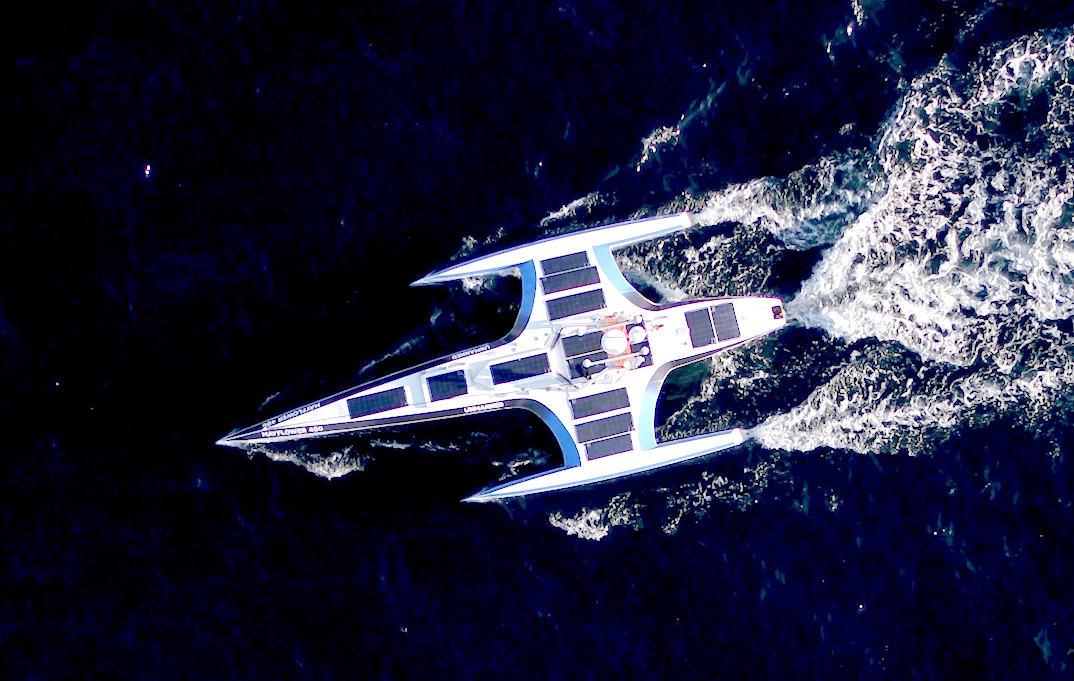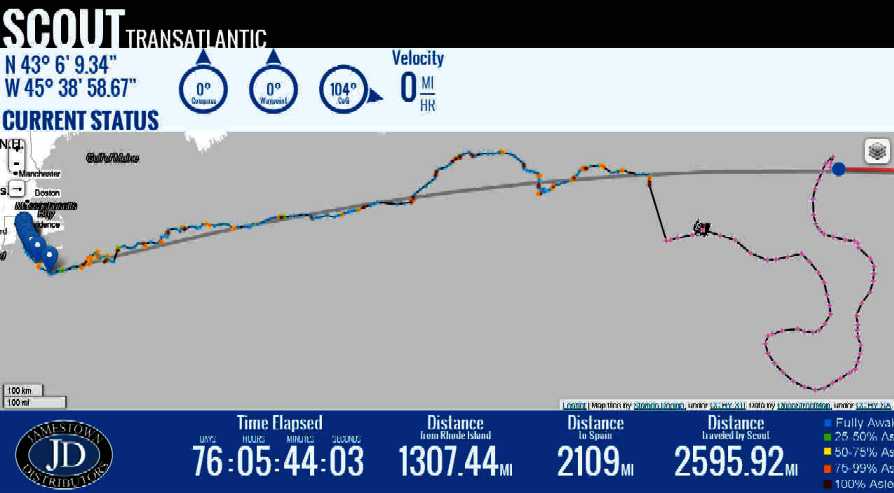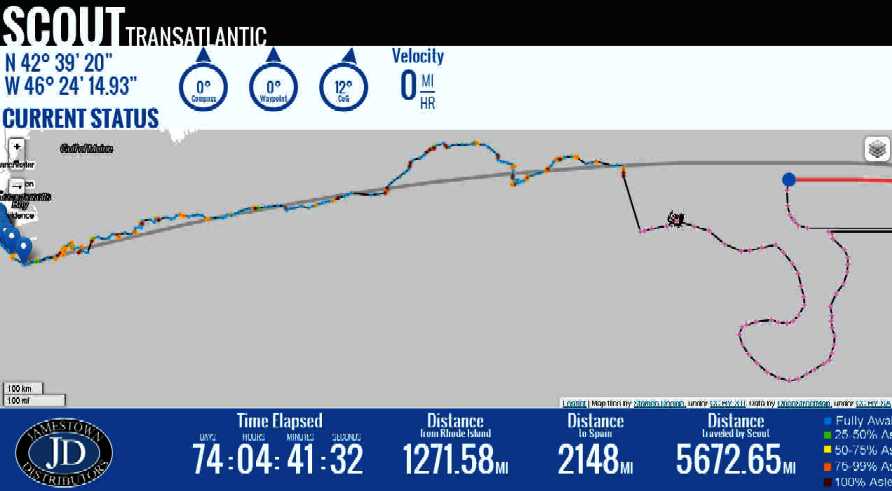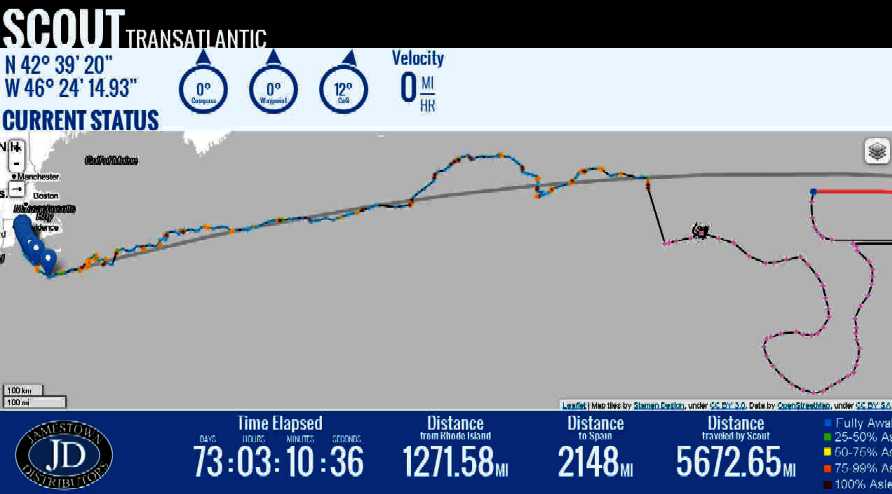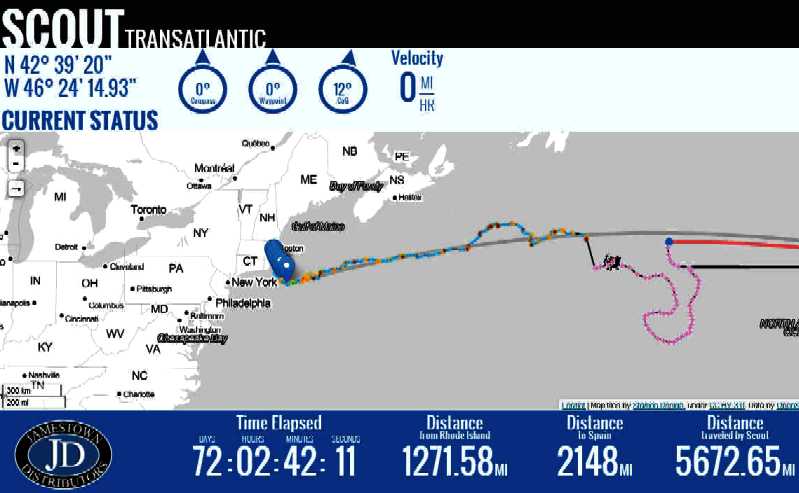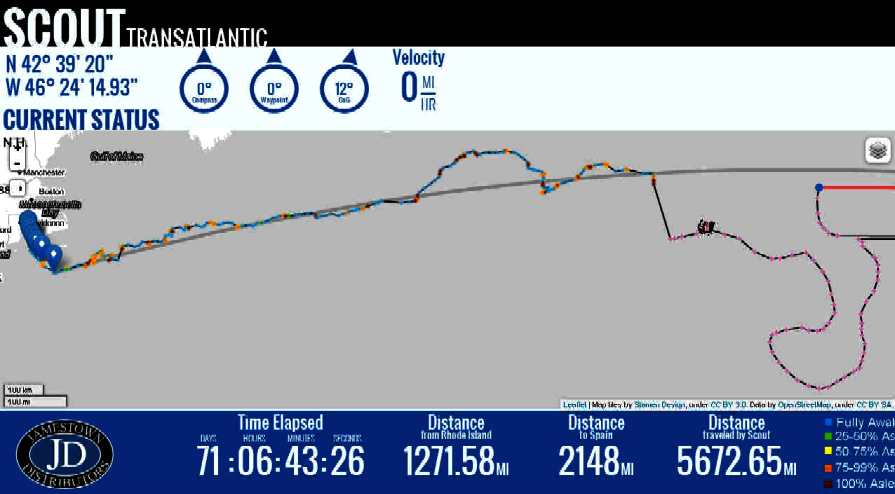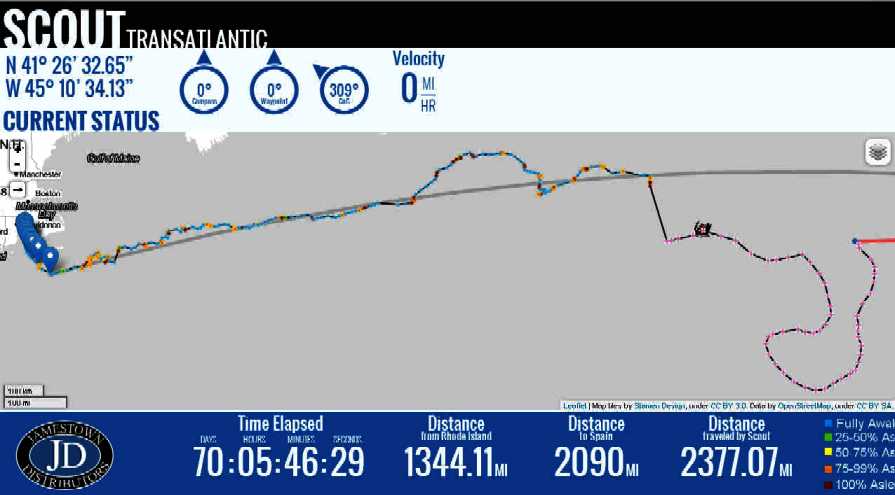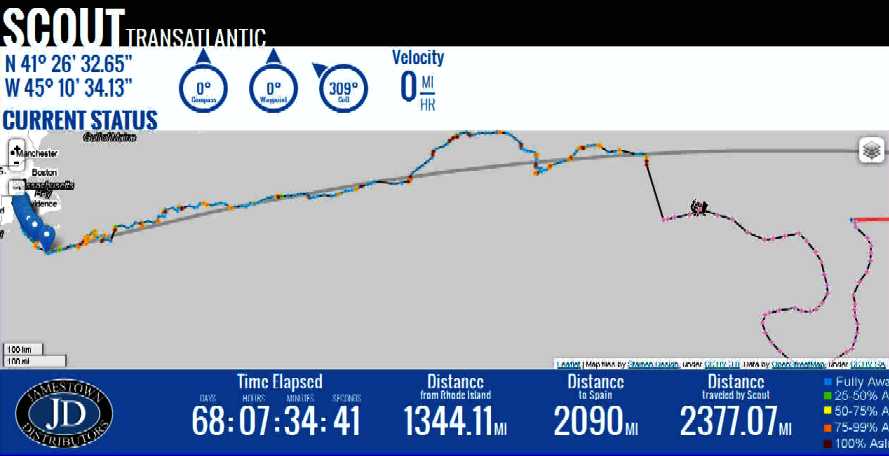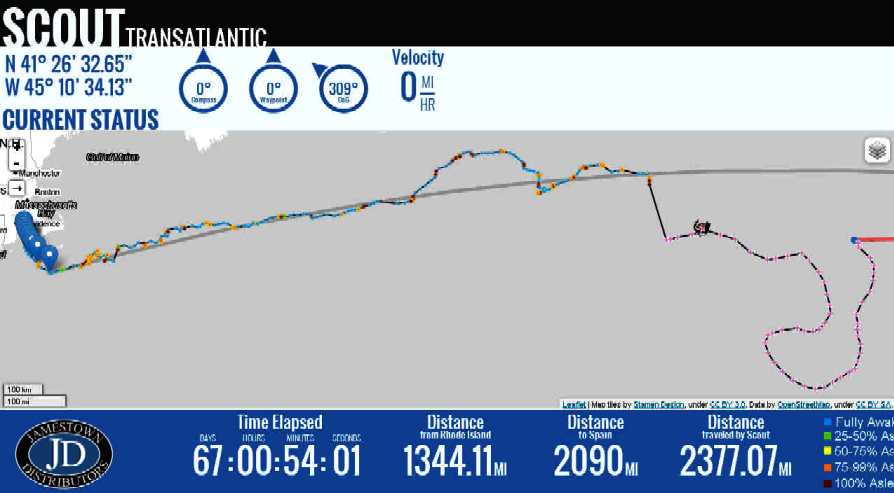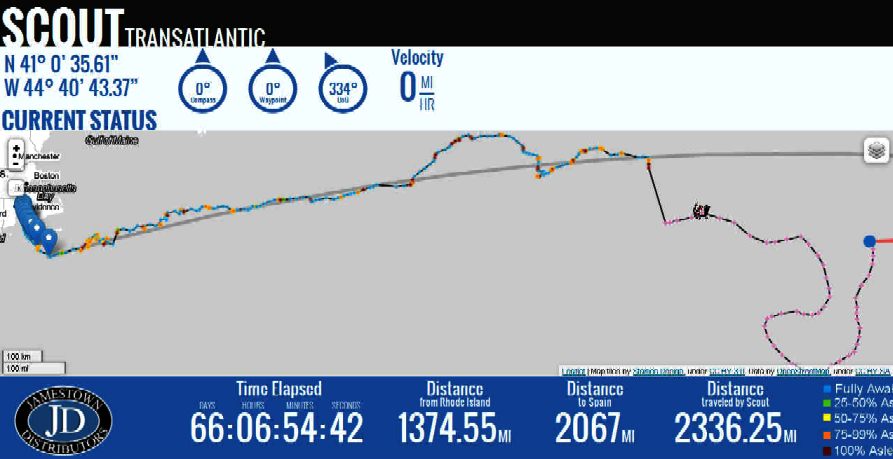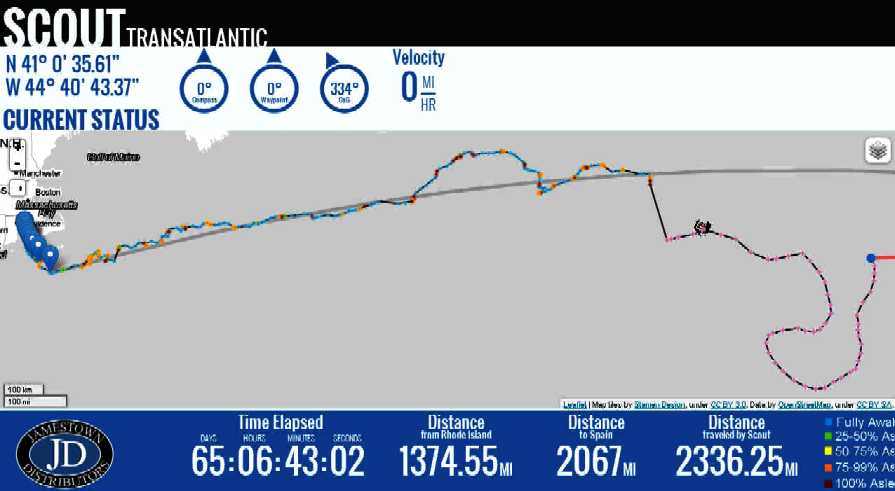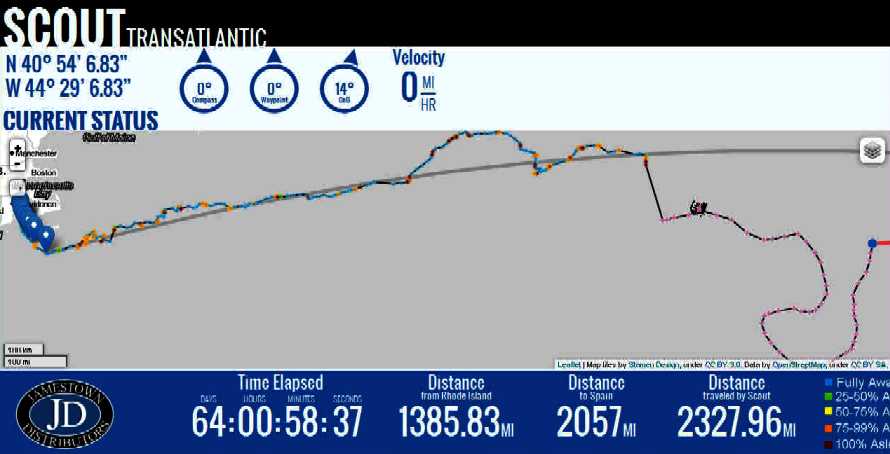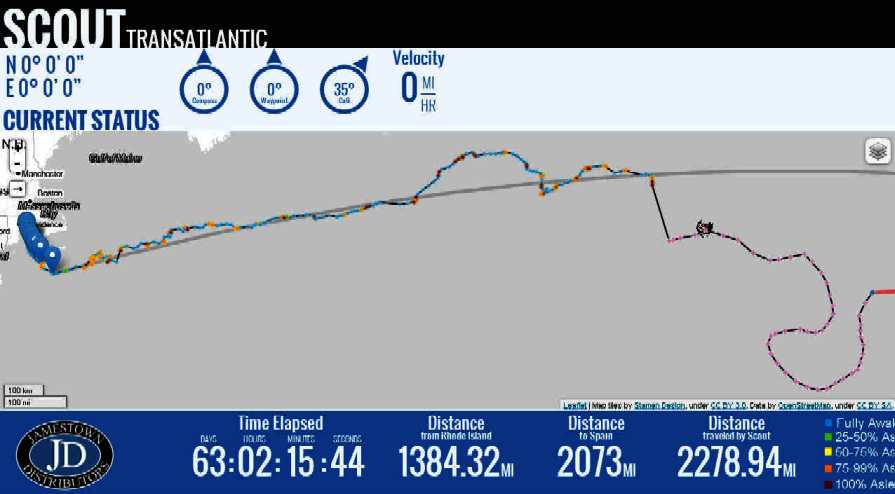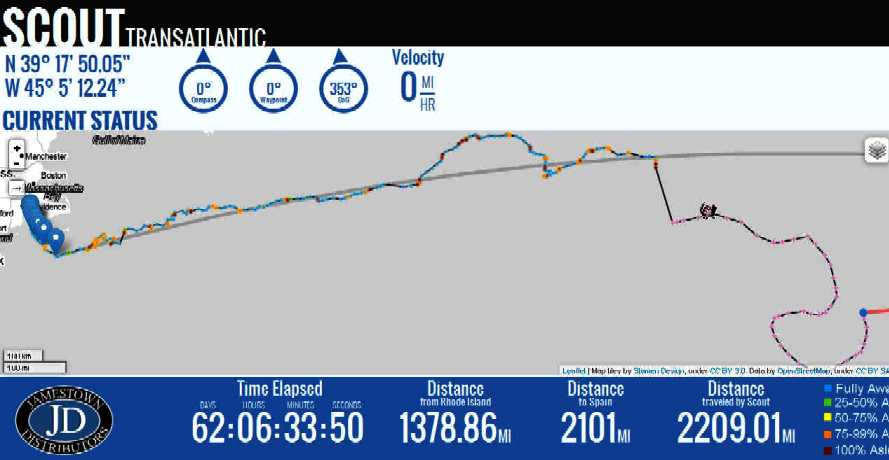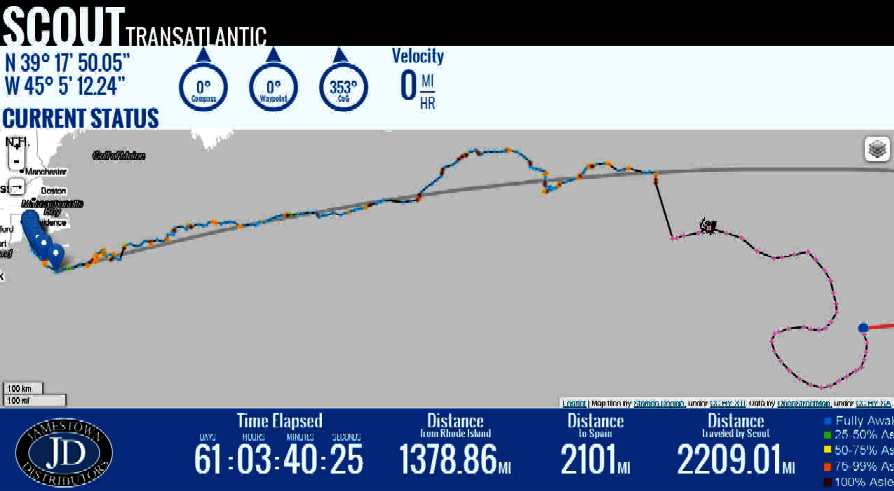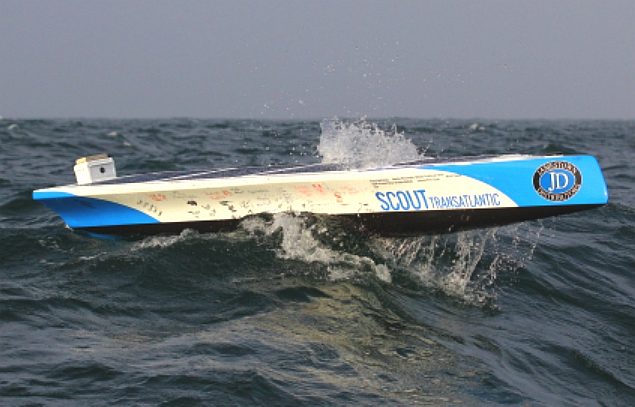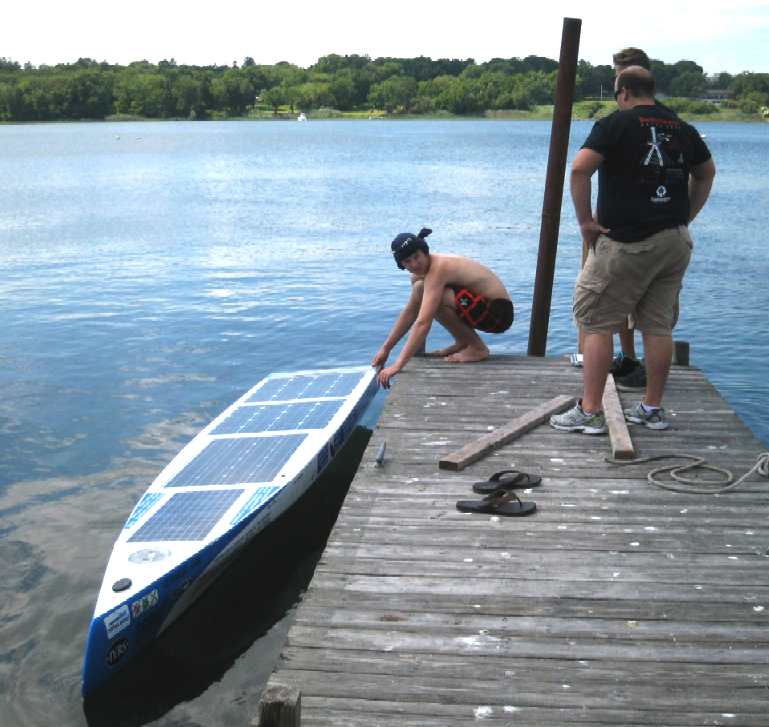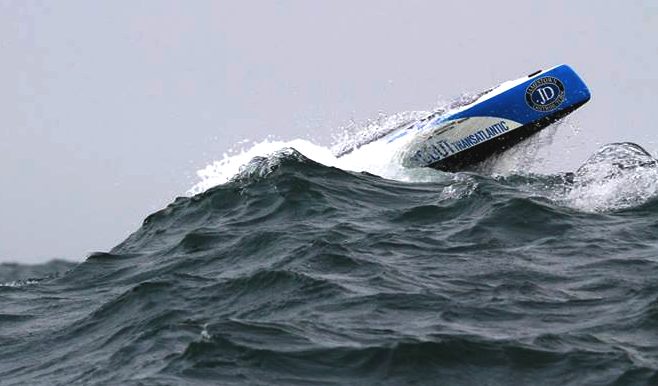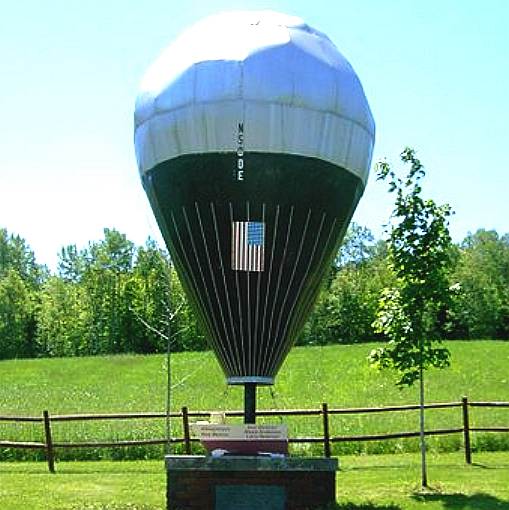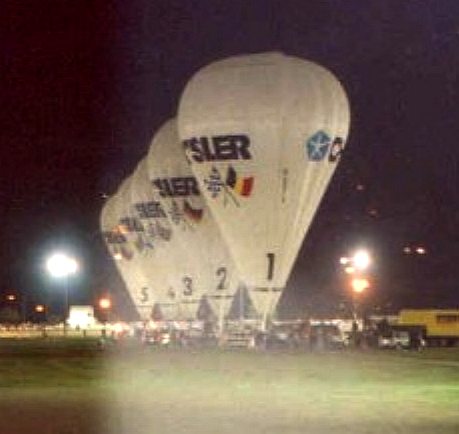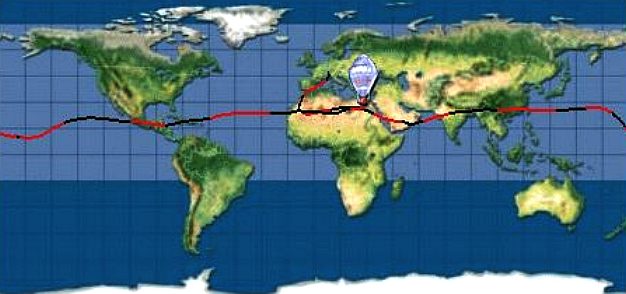|
SCOUT TRANSATLANTIC @ 75 DAYS
|
|||
|
AUTONOMOUS NEWS UPDATE 2021
Following on from the Scout Atlantic bash in 2013, in 2020, a team comprising Promare, IBM, and many other technology partners, decided to attempt to cross the Atlantic against the prevailing winds and currents. They set out to build a 100ft craft named Mayflower Autonomous Ship (MAS) for launch and an attempt, aiming for the 400th anniversary of the Pilgrim Fathers journey starting on the 6th of September 1620.
They never made that date, partly due to Covid 19, but did manage to get a hull in the water for the ceremonies in Plymouth, Devon in 2020. On the 15th June 2021, the unmanned craft departed from Plymouth in England, aiming for Plymouth, Massachusetts, USA. You can follow the journey on their blog: https://mas400.com/dashboard
MAS 400 - The fully autonomous trimaran Setting off from Plymouth, England on the 15th June 2021. There are solar panels, that presumably add to the diesel-electric setup. The idea is to be COLREGs compliant with a self learning program, as such vessels build a database. Much the same as with the current bevy of self-driving robotaxis and robotracks. The question is therefore, will ships beat trucks to the autonomous punch?
SCOUT 75th day update. Scout was meandering her way across the Atlantic at a leisurely pace that varies on her 2013 Atlantic debut - but has for the last few days been static (which we doubt) on the map, suggesting other instrument failure. So where is she for real? She was describing dramatic 'S' shaped curves in the process on an eloborate drift, rather than powered motion. One could though argue that she is now being powered by the wind and as such is a Microtrasat competitor by default - even though disqualified for not transmitting her true position. It's though a curious matter as to how the ocean currents alone are painting such a picture.
MICROTRANSAT UPDATE OCT 2013
On the sail powered front, a stoic Robin Lovelock launched the Snoopy Sloop again in October 2013 with similar results to his previous launches - due to slippage on a steering control component the robotic sailor crashed on rocks near Yarmouth rather sooner than hoped for. We must though remember that Edison tried a thousand experiments before perfecting the incandescent filament light bulb. So, nice one Robin and keep at it.
8 NOVEMBER 2013 STATS Time
Elapsed: 76 DAYS: 05 HOURS: 44 MINUTES: 18 SECONDS
6 NOVEMBER 2013 STATS Time
Elapsed: 74 DAYS: 04 HOURS: 41 MINUTES: 32 SECONDS Distance traveled by Scout
5672.65 M Velocity: 2.04 mph
5 NOVEMBER 2013 STATS Time
Elapsed: DAYS: 03 HOURS: 10 MINUTES: 36 SECONDS Distance traveled by Scout
5672.65 MI Velocity: 2.04 mph
4 NOVEMBER 2013 STATS Time
Elapsed: 72 DAYS: 02 HOURS: 42 MINUTES: 11 SECONDS
3 NOVEMBER 2013 STATS Time
Elapsed: 71 DAYS: 06 HOURS: 43 MINUTES: 26 SECONDS Distance traveled by Scout 5672.65
Velocity: 2.04 mph
2 NOVEMBER 2013 STATS Time
Elapsed: 70 DAYS: 05 HOURS: 46 MINUTES: 29 SECONDS
31 OCTOBER 2013 STATS Time
Elapsed: 68 DAYS: 07 HOURS: 34 MINUTES: 41 SECONDS
CURRENT STATUS: N 41° 26’ 32.65” W 45° 10’ 34.13” Compass 0° Waypoint 0° CoG 309°
30 OCTOBER 2013 STATS Time
Elapsed: 67 DAYS: 00 HOURS: 54 MINUTES: 01 SECONDS
29 OCTOBER 2013 STATS Time
Elapsed: 66 DAYS: 06 HOURS: 54 MINUTES: 42 SECONDS
28 OCTOBER 2013 STATS Time
Elapsed: 65 DAYS: 06 HOURS: 43 MINUTES: 02 SECONDS
27 OCTOBER 2013 STATS Time
Elapsed: 64 DAYS: 00 HOURS: 58 MINUTES: 37 SECONDS
26 OCTOBER 2013 STATS Time
Elapsed: 63 DAYS: 02 HOURS: 15 MINUTES: 44 SECONDS
25 OCTOBER 2013 STATS Time
Elapsed: 62 DAYS: 06 HOURS: 33 MINUTES: 50 SECONDS
CURRENT STATUS: N 39° 17’ 50.05” W 45° 5’ 12.24” Compass 0° Waypoint 0° CoG 353°
24 OCTOBER 2013 STATS Time
Elapsed: 61 DAYS: 03 HOURS: 40 MINUTES: 25 SECONDS Distance
traveled by Scout 2209.01
Velocity: 1.25 mph
Click on the image above to follow progress live
10 SEPTEMBER 2013 STATISTICS:
Distance
traveled by Scout 765.72 M Velocity 2.3 MI HR
CONCEPT - Scout is powered by solar panels. The idea is to get across the Atlantic autonomously. They are using much the same gps, tracking and computer equipment as the Microtransat teams seem to favour.
TELEMETRY - Telemetry information is relayed via Iridium 9612 every hour. Scout uses two Arduino micro computers; one to navigate and one to communicate via an Iridium transceiver. Dylan and Ryan worked on programming and electronics. We are not sure if Scout has a compass onboard. If not, that might help improve course keeping in between gps signaling delays. The base programming for Scout took 14 days with both engineers working for 15 hours a day while sipping a lot of energy drinks.
SPECIFICATIONS - We are not sure what the exact mass of the vessel is (around 140lbs), nor the size of the solar panels, so can only guess on these, and as a mono-hull at around 13 x 2 feet, she is going to be bouncing around all over the place (riding up and down waves), making wave drag very high - in the process reducing average speed. The route is roughly 3,473 miles. The boat is doing a lot of course correction (searching) according to the tracking map. We do not know if this is because of directional instability in the hull design from wave encounters, or maybe the algorithm for the steering is not frequent enough to steer a true course - possibly due to power saving or computing speeds. Who knows? We doubt the latter.
Guessing about the panels from pictures, it looks like they have about 1.6 m2 of panel area, that should provide around 230watts @ 17% efficiency. Then at 140lbs, the power to weight ratio is 3.7kW/ton. That is three times the power to weight ratio of PlanetSolar, which manages 5 knots from its two canoe shaped hulls (shape presented to the sea) using a large battery to even out loads overnight, etc. We must then conclude that the motor/propeller setup on the Scout is far from ideal in converting electrical energy to thrust, and of course that long fin generates quite a bit of resistance from area alone.
The estimates for hull speed were between 2-4 mph. The average speed at time of writing is 1.75 miles per hour. If Scout can keep that up she will complete her mission in 83 days. A speed of 1.8 mph will reduce that to 80.4 days and 1.85 mph will take the journey down to 78 days. So, conservatively, were looking at a record crossing in the region of 80-90 days. PlanetSolar did a shorter route in 22 days in August 2013 with a more efficient hull/propulsion setup, but that boat is manned. Mind you, if PlanetSolar were to be fitted with robotic navigation equipment, it would trounce a small boat like Scout.
HERE AND NOW September 25 2013 - David Schneider
Each year thousands of yachtsmen cross the Atlantic Ocean, but only few of their voyages set records. One crossing taking place now just might do that. A group of young men from Rhode Island are attempting an autonomous transatlantic crossing with a solar-powered boat they built in their spare time. David Schneider, a senior editor at IEEE Spectrum magazine, was at the midnight launch of their robotic boat called “Scout.”
In May of 2012, the PlanetSolar completed the first solar powered circumnavigation. At about that time a world autonomous navigation was proposed by the SolarNavigator team, also using a solar powered platform. Then in August 2013 PlanetSolar set the fastest solar record across the Atlantic, at 22 days. These events are not for a robotic boat.
Make sure to visit the Scout website at www.GoTransat.com
FAMOUS ATLANTIC CROSSINGS BY BALLOON
DOUBLE EAGLE II - Double Eagle II, piloted by Ben Abruzzo, Maxie Anderson, and Larry Newman, became the first balloon to cross the Atlantic Ocean, landing 17 August 1978 in Miserey near Paris, 137 hours 6 minutes after leaving Presque Isle, Maine. The attempt was successful at the point that the balloon crossed the Irish coast, on the evening of 16 August 1978, as notified to the crew by Shannon Airport.
CHRYSLER TRANSATLANTIC RACE 1992 - Taking off from Bass Park the September 15 1992, five teams of balloonists set out that clear summer night on a race across the Atlantic, an event conceived in 1982 by Don Cameron and Alan Noble (UK). The Belgian team won two days later when they reached Portugal at 3:48 a.m. - 2,580 miles from Bangor and 114 hours, 27 minutes after launching. They finally landed at Peque, Spain.
BREITLING ORBITER 3 - It wasn't until 1981 that the first attempt was made to try and fly around the world in a hot air balloon. 9 years later it had become a race and even the World Air Sports Federation had laid down rules. Before Bertrand and Jones there were a number of others who tried, but never managed to complete the challenge. Among them were: Max Anderson (Jules Verne), Larry Newman (Earthwind), Richard Branson and Per Lindstrand (Virgin Global Challenger), Bertrand Piccard (Breitling Orbiter), Steve Fossett (Solo Spirit) and Andy Elson (Cable and Wireless). It was became the most sought after title in the ballooning world. The BO3 took off from Chateaux D'Oex in the Swiss Alps on 1st March 1999. On 20th March 1999, the Breitling Orbiter 3 crossed the last meridian and landed in Mauritania, North Africa the next day, becoming the first hot air balloon to circumnavigate the earth covering a ground breaking distance of 42,810 KM.
JONATHAN TRAPPE 2013 - The American aviator from Caribou, Maine, began the first attempt to cross the Atlantic suspended by 370 helium balloons. Jonathan Trappe took off from Caribou, Maine, on Thursday morning as his capsule was lifted by 370 helium-filled balloons in heavy fog and he headed east from the US.
Scout Video
LINKS
http://spectrum.ieee.org/automaton/robotics/diy/robotic-boat-hits-1000-mile-makr-in-transatlantic-crossing http://hereandnow.wbur.org/2013/09/25/solar-boat-atlantic http://www.orbiterballoon.com/home.aspx http://en.wikipedia.org/wiki/Single-Handed_Trans-Atlantic_Race https://twitter.com/ScoutTRANSAT https://www.facebook.com/ScoutTransatlantic http://www.wpri.com/on-air/green-team/ri-students-design-solar-powered-boat http://www.solarracing.org/2013/06/10/autonomous-solar-powered-boat-to-cross-the-atlantic/ http://letsmakerobots.com/node/38270 http://www.kickstarter.com/projects/601285608/scout-the-autonomous-transatlantic-boat http://www.kickstarter.com/help/school#defining_your_project http://www.kickstarter.com/start?ref=footer http://www.gotransat.com/ http://www.gotransat.com/tracking/ http://makezine.com/magazine/transatlantic-drone-takes-to-the-sea/ http://www.behance.net/gallery/SCOUT-Transatlantic/10153015 World
Sea
conditions, Temperatures
& Sunshine http://www.yellowbrick-tracking.com/ http://international.findmespot.com/ http://www.amsat.org/ Here and Now September 25 2013
Blackcurrant 1 | Blackcurrant 2 | Catamaran Hull Design Drag | SWASH | SWATH | Trimaran
|
|||
|
This website is Copyright © 2013 Bluebird Marine Systems Ltd. The names Bluebird™, Bluefish™, Solar Navigator™,Blueplanet Ecostar BE3™, Utopia Tristar™ and the blue bird and fish in flight logos are trademarks. The color blue is an essential element of the marks. All other trademarks are hereby acknowledged.
|
|||

